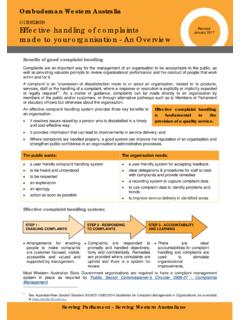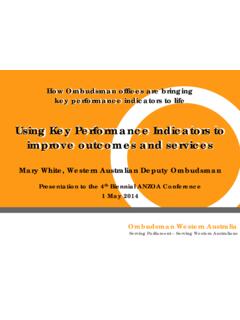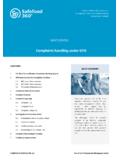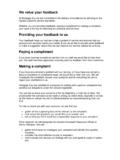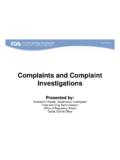Transcription of Effective Complaint Handling Systems Checklist
1 Ombudsman Western Australia Complaint Handling Systems Checklist Serving Parliament - Serving Western Australians Revised May 2011 EEffffeeccttiivvee ccoommppllaaiinntt hhaannddlliinngg ssyysstteemmss An Effective Complaint Handling system is one that provides confidence that complaints are dealt with effectively through the following three steps: Arrangements for enabling people to make complaints are customer focused, visible, accessible and valued, and supported by management. complaints are responded to promptly, handled objectively, fairly and confidentially. Remedies are provided where complaints are upheld and there is a system for review. There are clear accountabilities for Complaint Handling and complaints are used to stimulate organisational improvements. FFiitt ffoorr ppuurrppoossee An Effective Complaint Handling system should be a fit for purpose system . This is a system that is varied to fit an organisation s circumstances and is proportionate to the number and type of complaints it receives.
2 Decisions about building a fit for purpose system could incorporate the following considerations: The number and demographics of the organisation s customers, and how they generally communicate with the organisation; The nature and breadth of the organisation s interactions with the public; The level of complaints that is considered reasonable for the organisation (by examining trends in its level of complaints over time and industry benchmarks); The organisation s risk management strategy complaints are an important way of monitoring and mitigating any risks; The value the organisation derives, or wishes to derive, from complaints to improve its operations over time, as well as other information needs of management; and The cost of operating a Complaint Handling system . CChheecckklliisstt ffoorr ccoommppllaaiinntt hhaannddlliinngg ssyysstteemmss The following Checklist sets out ten good practice principles for Complaint Handling .
3 When using the Checklist , consider the type of system that will meet your needs. Not all components of the Checklist will apply to your organisation. They are prompts to guide your decision making in designing the right type of system for you. Some aspects of the principles may be more relevant to your organisation than others and different organisations may be able to meet the Complaint Handling principles in different ways. Organisations can use this Checklist in conjunction with the Ombudsman s guideline for Effective Handling of complaints made to your organisation An overview to assess their Complaint Handling system against the key features of an Effective system . This Guideline, along with more detailed guidelines about the steps within the Complaint Handling process, are available on the Ombudsman WA website at 1 - ENABLING complaints STEP 2 - RESPONDING TO complaints STEP 3 - ACCOUNTABILITY AND LEARNING Serving Parliament - Serving Western Australians Complaint Handling Systems Checklist Revised May 2011 SStteepp 11 -- EEnnaabblliinngg CCoommppllaaiinnttss CCuussttoommeerr ffooccuuss Principle: The organisation is committed to Effective Complaint Handling and values feedback through complaints .
4 Do you have customer service standards and a Complaint Handling process that is valued, supported and followed by management? Is your organisation open to feedback from customers, including through complaints ? Are the benefits of complaints and the Complaint Handling process communicated to staff, including new staff at their induction? VViissiibbiilliittyy Principle: Information about how and where to complain is well publicised to customers, staff and other interested parties. Is information about how to make a Complaint and how it will be handled readily available, for example, on your website and front counter? Are the contact details for making complaints prominently displayed, for example. in brochures, on your website, or on posters? Are front-line staff aware of the Complaint Handling process and the contact details for your complaints officer? Does your Complaint Handling system identify alternative external parties the complainant can go to with a Complaint ?
5 AAcccceessssiibbiilliittyy Principle: The process for making a Complaint and investigating it is easy for complainants to access and understand. Are complaints handled at no charge to the complainant and is this information clear in publications about how to make a Complaint ? Can complaints be made in a number of different ways verbally and in writing, for example, in person, over the phone, and in writing via email, fax, SMS and letter? Do you provide access to translating and interpreting services for non-English speaking people to assist them to make a Complaint ? Is the process for making a Complaint accessible and easy to use by all members of the community including Indigenous Australians, children and young people, people living in regional and remote areas, people with disabilities and people from culturally and linguistically diverse backgrounds? The Ombudsman WA publication Making your Complaint Handling system accessible, may assist you in making your Complaint Handling system accessible to all members of the diverse Western Australian community.
6 CUSTOMER FOCUS VISIBILITY ACCESSIBILITY Serving Parliament - Serving Western Australians Complaint Handling Systems Checklist Revised May 2011 SStteepp 22 -- RReessppoonnddiinngg ttoo CCoommppllaaiinnttss RReessppoonnssiivveenneessss Principle: complaints are acknowledged in a timely manner, addressed promptly and according to order of urgency, and the complainant is kept informed throughout the process. Do you provide guidance to staff on how to respond to and prioritise complaints (for example through guidelines) and does this cover: who will be responsible for Handling the complaints ; how to assess complaints to decide what can be resolved easily and what requires investigation; how and when the complainant will be kept informed during the process; how to identify, handle and, if necessary, refer public interest disclosures and complaints about misconduct and corrupt behaviour?
7 Is each Complaint acknowledged promptly (within a specified timeframe) and is the complainant (and, if applicable, the person who is the subject of the Complaint ) kept informed throughout the process? Are complaints addressed promptly and in order of urgency and do you have performance targets which set out the timeframe for resolving complaints ? Are front-line staff empowered to resolve certain complaints at the earliest point of contact with the complainant? Does your organisation have special arrangements for responding to complaints from particular client groups, for example, Indigenous Australians, children and young people, people living in regional and remote areas, people with disabilities and people from culturally and linguistically diverse backgrounds? OObbjjeeccttiivviittyy aanndd FFaaiirrnneessss Principle: complaints are dealt with in an equitable, objective and unbiased manner.
8 This will help to ensure that the Complaint Handling process is fair and reasonable. Unreasonable complainant conduct is not allowed to become a burden. Do you ensure that your staff are aware of, and given guidance on, conflict of interest requirements and how to make declarations where required? Are relevant staff given guidance or training in Complaint resolution and evidence based investigation techniques and Effective Handling of unreasonable conduct by complainants or people who are the subject of a Complaint ? Is the complainant (and, if applicable, the person who is the subject of the Complaint ) given: sufficient opportunity to present their position and is the information they provide given adequate consideration, taking into account all relevant material and factors; the opportunity to comment on any adverse findings; and reasons for the decisions made about the outcome of a Complaint ?
9 Where appropriate, is there a process in place for a suitable colleague or superior to review the decision made by the person Handling the Complaint prior to finalisation? The Ombudsman WA publications Conducting administrative investigations, Investigation of complaints , Procedural fairness and Dealing with unreasonable complainant conduct may assist your staff when Handling complaints . RESPONSIVENESS OBJECTIVITY & FAIRNESS CONFIDENTIALITY REMEDY REVIEW Serving Parliament - Serving Western Australians Complaint Handling Systems Checklist Revised May 2011 SStteepp 22 -- RReessppoonnddiinngg ttoo CCoommppllaaiinnttss ((ccoonnttiinnuueedd)) CCoonnffiiddeennttiiaalliittyy Principle: Personal information related to complaints is kept confidential. Do you advise staff about confidentiality requirements when Handling or involved in complaints ? Are the personal details of the complainant kept confidential and only used for the purposes of addressing the Complaint ?
10 Are the personal details of any people who are the subject of the Complaint kept confidential and only used for the purposes of addressing the Complaint and any follow-up actions? RReemmeeddyy Principle: If a Complaint is upheld, the organisation provides a remedy. Do you support and give guidance to staff on providing remedies when complaints are upheld? Are responsibilities for providing remedies clearly defined and at the appropriate level in the organisation, for example, are front-line staff empowered to provide appropriate remedies? Do you give guidance to staff on the appropriate use of remedies? Are the reasons for decisions relating to remedies provided to the complainant? The Ombudsman WA publication Remedies and redress may assist you to provide appropriate remedies when resolving complaints . RReevviieeww Principle: There are opportunities for internal and external review and/or appeal about the organisation s response to the Complaint , and complainants are informed about these avenues.
